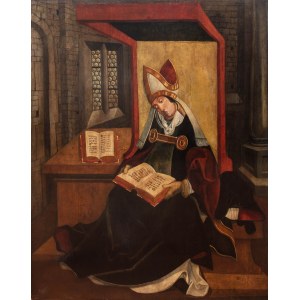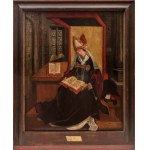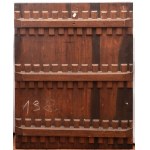mixed technique, linden board (?), 96 × 77 cm
Origin:
- St. Magnus Abbey, Füssen,
- After secularization, private collection, Hersbruck,
- Lempertz auction house, Cologne
- private collection, Munich
- Hampel auction house, Munich
- private collection, Poland
Exhibited:
- Presentation of Wit Stwosz's painting Saint Augustine, Archdiocesan Museum of Cardinal Karol Wojtyla in Cracow, May 13, 2022
- Presentation of Wit Stwosz's painting Saint Augustine, Museum of the Archdiocese of
Warsaw, December 17, 2021, January 30, 2022
Literature:
- Matthias Weniger, "Pinsel statt Schnitzmesser. Veit Stoß als Maler" [in:] "Kunst und Kapitalverbrechen. Veit Stoß" - Tilmann Riemenschneider und der Münnerstädter Altar, exhibition catalog, ed. by Frank Matthias Kammel, Munich 2021, p. 154 (ill.)
- Zdzisław Kępiński, "Wit Stwosz," Warsaw 1981, pp. 112-113
- Alfred Stange, "Deutsche Malerei der Gotik. Franken, Böhmen und Thüringen-Sachsen in der Zeit von 1400 bis 1500", Munich-Berlin 1958, pp. 79-82 (mentioned)
- Ernst Buchner, Veit Stoss als Maler, "Wallraf-Richartz-Jahrbuch", 1952, vol. XIV, item 106, p. 120 (il.).
"The Füssen figures have a grandeur and breadth of breath in their new statuesque being that must be appreciated. It is not the anecdote that should be sought here, but the greatness of the human appeal and its monumental dignity. It is not attractiveness that is important here, but seriousness. And that is Stwosz's."
Z. Kępiński, "Wit Stwosz", Warsaw 1981, p. 113.
"Stwosz's artistic talent is evidenced not only by his manual proficiency, which, by the way, reaches a virtuoso level in his works. Not only the strength of his artistic vision, which enabled him to create the extraordinary theatrum in the altar of St. Mary's, and at the same time expressed in freely composed small figures of prophets, full of expressive movement and depth of spiritual expression, placed in the margin, in the surround of the main scene. Above all, perhaps, the realism of his art, understood as adapting it to the needs of the time, to the mentality of the environment for which it was created." J. Kębłowski, Polish Gothic Art, Warsaw 1976, p. 174.
Wit Stwosz went down in Polish art history as an outstanding artist, known mainly for his sculptural works - his most notable works include the altarpiece in St. Mary's Church in Cracow and the tombstone of Casimir Jagiellon, which is one of the most important works of late Gothic sculpture in Poland. In 1477, as a formed and mature artist, he came to Krakow to make a retable for St. Mary's Church. The pentaptych with the Dormition of Mary and scenes from the life of Mary and Jesus, completed in 1489, was the largest Gothic altarpiece in Europe and brought the sculptor fame. Circa. 1491, Stwosz also made a stone Crucifix for St. Mary's Church in Cracow, commissioned by Henryk Slacker. In addition to the marble tombstone of Casimir Jagiellon in Krakow Cathedral, he was also the creator of the tombstones, of Bishop Piotr of Bnin in Wloclawek Cathedral and Archbishop Zbigniew Oleśnicki in Gniezno Cathedral, as well as a bronze cast slab of Callimach (Filip Buonaccorsi) in the Dominican Church in Krakow. After returning to Germany in 1495, already an established and wealthy artist, he settled in Nuremberg. There, a new period in Wit Stwosz's life began. The city itself was home to a number of prominent artists' studios - Peter Vischer, Adam Krafft or, perhaps most importantly, Albrecht Dürer, who also returned from his first trip to Italy in 1495. With competition greater than in Poland, the creator of the altarpiece in St. Mary's Church in Cracow had to expand his scope of activity - he began to deal not only with sculpture but also with painting or printmaking. In addition, he devoted part of his time to trading and financial speculation, which put him on the brink of bankruptcy and got him into quite a bit of trouble.
Even before 1500, Stwosz invested a large sum in textile speculations, but the person from whom he bought them went bankrupt. The artist, unable to recover the amount owed to him in court, forged a surety document through which he was to recover part of the invested sum. The forgery was discovered, however, and Stwosz had to flee to the Nuremberg Carmelite monastery, where his son Andrew was a monk. While there, he reached a settlement on the promissory note with its issuer. However, he was still outlawed for the mere fact of forgery. Having left the monastery, Stwosz avoided the penalty of death or blinding thanks to the intercession of his son-in-law Jörg Trummer by the Bishop of Würzburg Lawrence of Bibra and the knight Betz von Romrodt. The punishment was limited to burning a stigma on both cheeks with a hot iron and forbidding him to leave the city for the rest of his life. However, he disobeyed the ban and fled to Münnerstadt, where the aforementioned son-in-law lived, which led to a new conflict with the city council.
The Wit Stwosz plaque presented at auction is an absolutely unique work on the world art market. It even constitutes an unprecedented in circulation and thus extremely valuable example of the artist's painting activity. St. Augustine, one of the four Fathers of the Church and a saint of both the Catholic, Orthodox and Lutheran churches, is depicted in the convention of the late Gothic broken style. The figure, immersed in reading, sits on a throne under a canopy, in a cell illuminated by a lomo window. In rendering the interior and modest furnishings, Stwosz used conventional perspective. The saint is clad in dynamically draped robes with sharp folds and curves characteristic of Stwosz's workshop. The work is rendered in muted, somewhat dim colors.
The Füssen retable consisted of a central cabinet, containing sculptures, and two pairs of movable wings, decorated on both sides. The inner wings were decorated with reliefs that are lost today. The rest of the decoration consisted of twelve painted panels with images of saints. Of this ensemble, six quatrefoils have survived to this day. Two pairs of movable wings were meant to present further reliefs: the inner doors presented images of the Apostles (St. Andrew, St. Peter and St. Paul, and St. James the Elder, the Younger and St. John the Evangelist) in the upper zone, and the Holy Helpers (St. Magnus, St. Dionysius and St. George, and St. Idzi, St. Erasmus and St. Blaise) in the lower zone (now in the Staatsgalerie Füssen). Two other panels were placed on either side of the outer wing of the polyptych, at the bottom (now in private collections). The inner quatrefoil depicted the intercessors St. Barbara, St. Catherine, St. Margaret and St. Dorothy, and on the reverse, visible when the altarpiece was fully closed, was an image of St. Augustine. It was adjacent to three other depictions of the Church Fathers, not preserved today.
The painting was attributed to the Veit Stoss workshop in 1952 by Prof. Ernst Buchner, who attempted to reconstruct the original layout of the sculpture-painting polyptych from the Church of St. Magnus in Füssen, Bavaria (Allgäu region). In 2020, Dr. Matthias Weniger of the Bavarian National Museum in Munich confirmed Buchner's attribution, publishing the featured work in the exhibition catalog "Kunst & Kapitalverbrechen. Veit Stoß, Tilmann Riemenschneider und der Münnerstädter Altar" as the work of Veit Stoß and the workshop.
Recently viewed
Please log in to see lots list
Favourites
Please log in to see lots list














